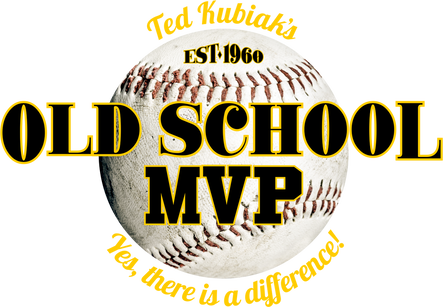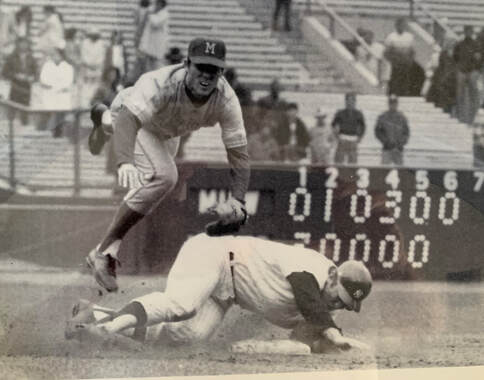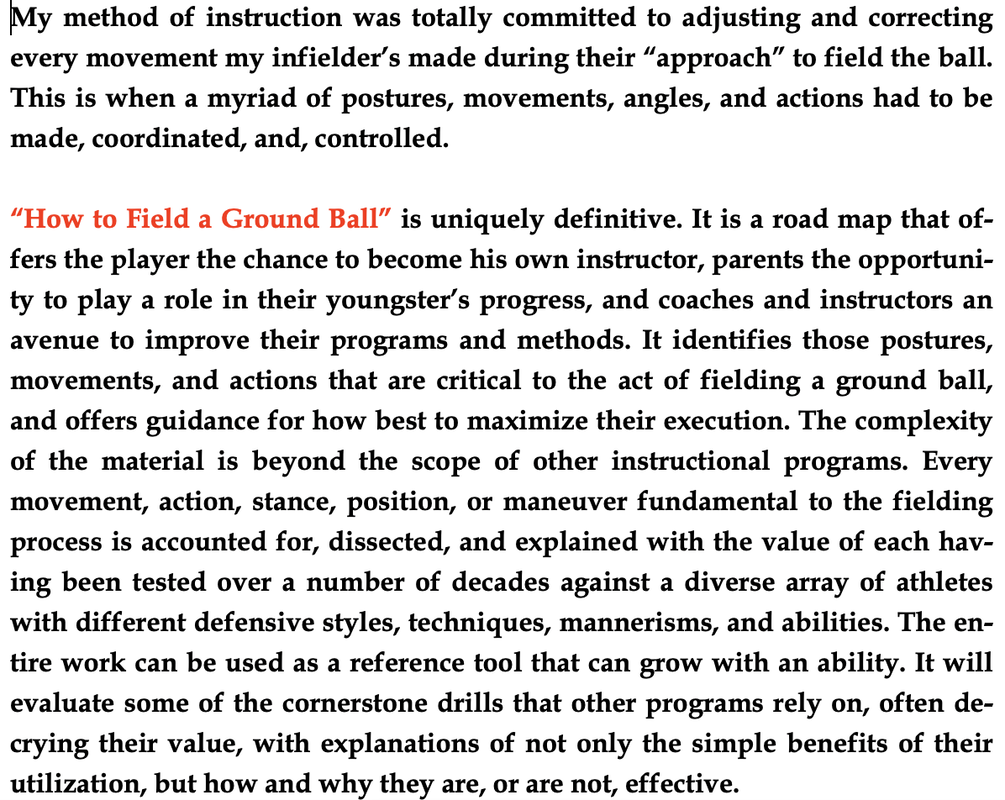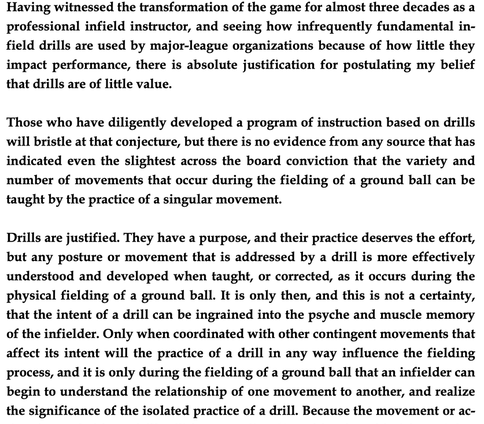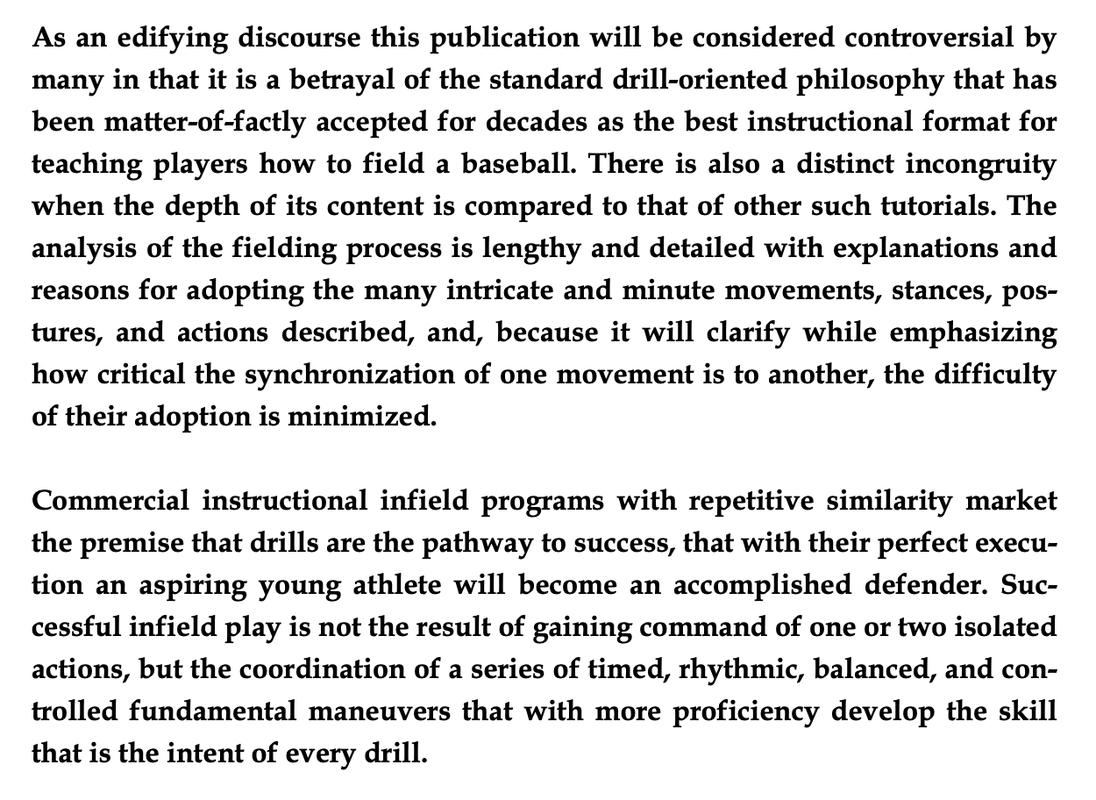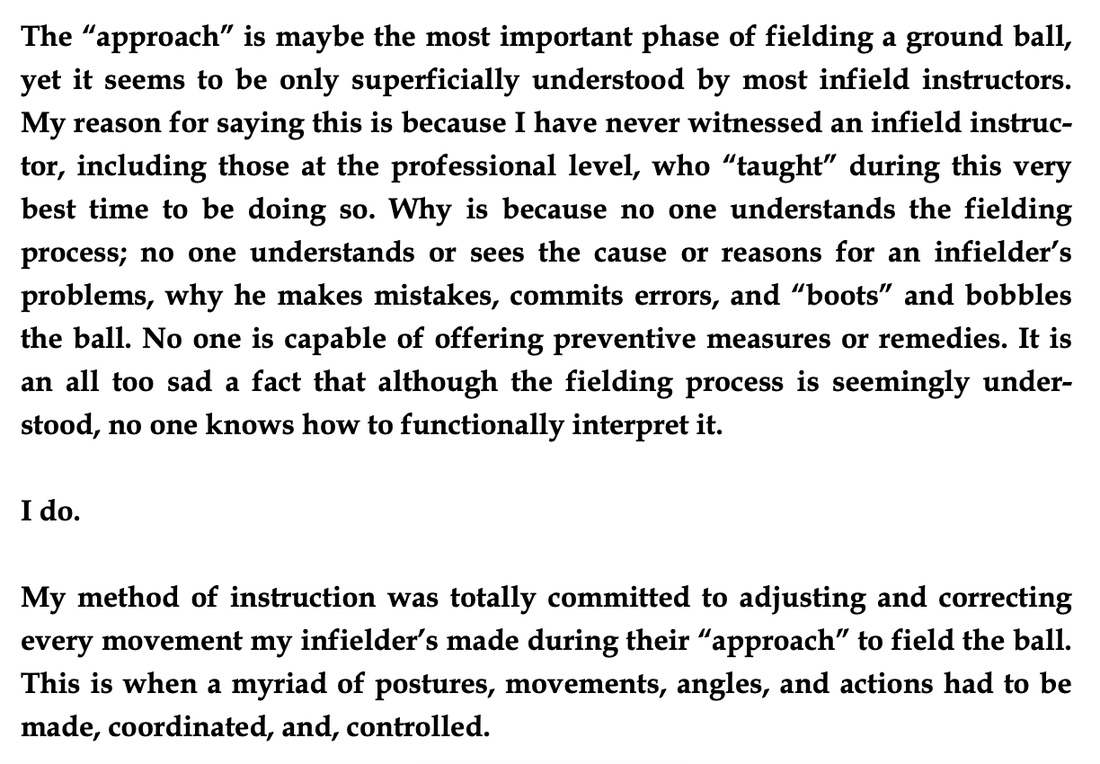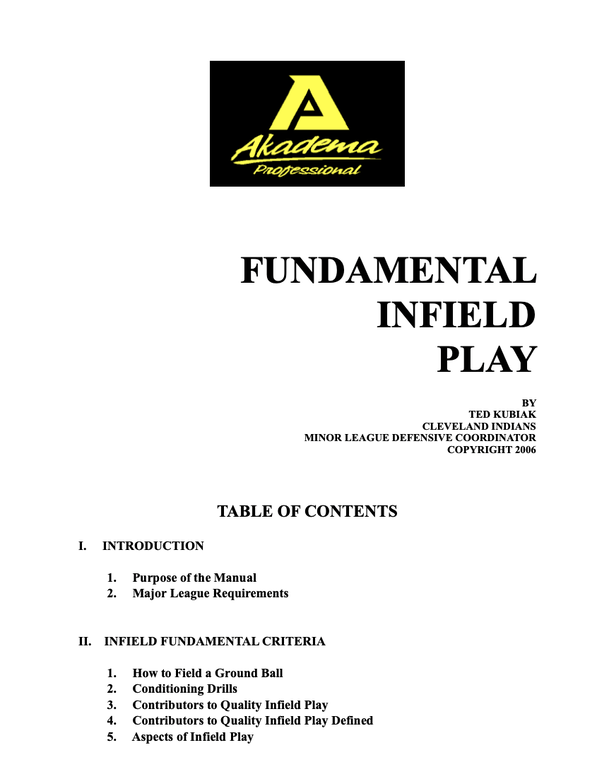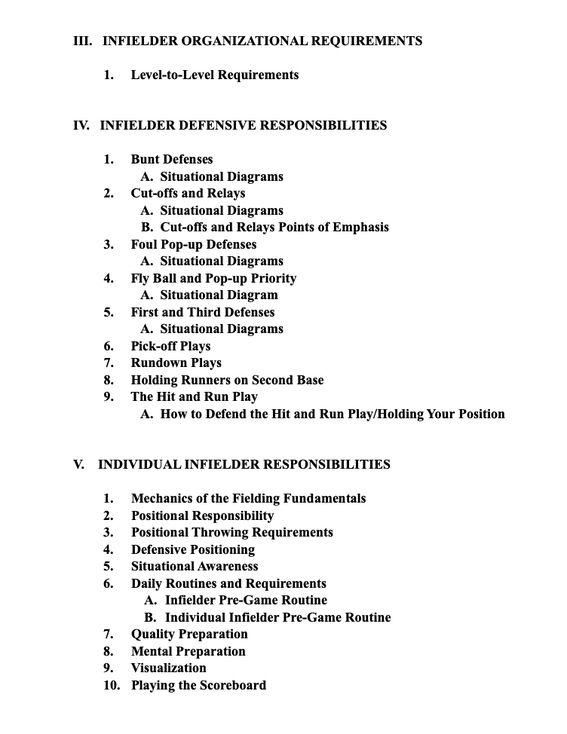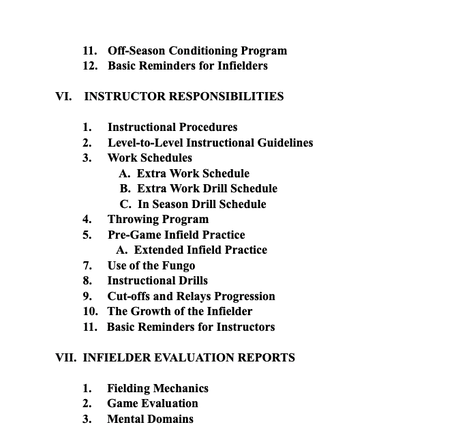CALLING ALL COACHES!
WHY LISTEN TO ME?
To be honest, I know more than you do...I know I can help you.
...not because I had a ten-year major-league career, but because of what I taught myself that allowed me to play that long in the major leagues. With no understanding of what it took to field ground balls consistently, and with no help from anyone, I spent the first few years of my professional career examining the fielding process looking for anything that I could do that would help me become a better infielder. Dissecting that process as best I could I recognized a number of movements whose importance I'd never before considered that not only contributed to but played a significant role in redefining and improving my play.
Everything I discovered is explained in my 18,000-word, fifty-four-page document...
"HOW TO FIELD A GROUND BALL"
I will teach you everything I taught myself.
During my era I was regarded as one of the best infielders in the major leagues, and though that gives me some legitimacy, it's what I understand about the fielding process that is important. It sets me apart from other instructors. If you download my document, what I will teach you will improve your knowledge of the movements involved in the successful and consistent fielding of ground balls, thereby improving your ability as an instructor.
My method of instruction contradicts the approach used by every other infield instructor because...
I NEVER RELIED ON DRILLS.
It is easy to be fooled into believing that drills will improve an infielder, but the postures and actions they represent are rarely duplicated. It is the infielder's innate athleticism that ultimately controls his movements.
An infielder can do drills all day, and still not be able to field ground balls consistently.
As a professional infield instructor for twenty-five years, I found that drills have no significant relationship to the development of the timing, rhythm, balance, and control that are the critical elements of the fielding process.
Drills are designed to teach specific postures, actions, and maneuvers that occur during the fielding of a ground ball, but, by themselves, they do not teach anyone how to field it. Only an instructor with the ability to adjust and correct a player's movements and actions according to that player's athleticism can do that.
Over time I found that making adjustments to the fielding mechanics of my infielders while they were actively fielding ground balls that were ROLLED--not hit--to them was the most effective way to improve their play.
Many of the drills taught on other internet sites have no bearing on how a ground ball is fielded.
"HOW TO FIELD A GROUND BALL"
....will teach you what takes place during the fielding process. You will learn about movements you've never heard anyone mention, or reference, movements that when understood, will improve your infielders, and elevate the quality of your program. You will see your infielders in a different light, see movements you've never noticed, and understand how to correct or alter them. You will become a better instructor.
My document will answer such things as...
-when instruction is most effective
-how to improve an infielder's range.
-the value of "charging" the ball.
-what not to teach.
-the best way to condition an infielder.
-what every infielder should do on every pitch.
-the importance of the "phantom" movement.
-why movements must coordinate.
-the drill or two that have value.
-what it means to be "embedded" with an infielder.
-why ground balls are "booted" or "bobbled."
-what a "trigger point" is.
-the value of "funneling" the ball.
-the drawback of "alligator hands."
-the role of the infielder's head.
-how to move for a ball "before" it is hit.
-the importance of "angles."
-what a good infield instructor does every day.
-what movements the infielder's legs control.
Not only will I tell you what to do, I will explain how to do it.
What I have written is simple, straight forward, and encyclopedic. It will walk you through every movement that occurs from just before a pitch is thrown to the point the ball is fielded,
You will not find another explanation of the fielding process to be as comprehensive as is the content of...
"HOW TO FIELD A GROUND BALL"
If you put in the time to absorb my document, you will be amazed at how differently you see your infielders.
...not because I had a ten-year major-league career, but because of what I taught myself that allowed me to play that long in the major leagues. With no understanding of what it took to field ground balls consistently, and with no help from anyone, I spent the first few years of my professional career examining the fielding process looking for anything that I could do that would help me become a better infielder. Dissecting that process as best I could I recognized a number of movements whose importance I'd never before considered that not only contributed to but played a significant role in redefining and improving my play.
Everything I discovered is explained in my 18,000-word, fifty-four-page document...
"HOW TO FIELD A GROUND BALL"
I will teach you everything I taught myself.
During my era I was regarded as one of the best infielders in the major leagues, and though that gives me some legitimacy, it's what I understand about the fielding process that is important. It sets me apart from other instructors. If you download my document, what I will teach you will improve your knowledge of the movements involved in the successful and consistent fielding of ground balls, thereby improving your ability as an instructor.
My method of instruction contradicts the approach used by every other infield instructor because...
I NEVER RELIED ON DRILLS.
It is easy to be fooled into believing that drills will improve an infielder, but the postures and actions they represent are rarely duplicated. It is the infielder's innate athleticism that ultimately controls his movements.
An infielder can do drills all day, and still not be able to field ground balls consistently.
As a professional infield instructor for twenty-five years, I found that drills have no significant relationship to the development of the timing, rhythm, balance, and control that are the critical elements of the fielding process.
Drills are designed to teach specific postures, actions, and maneuvers that occur during the fielding of a ground ball, but, by themselves, they do not teach anyone how to field it. Only an instructor with the ability to adjust and correct a player's movements and actions according to that player's athleticism can do that.
Over time I found that making adjustments to the fielding mechanics of my infielders while they were actively fielding ground balls that were ROLLED--not hit--to them was the most effective way to improve their play.
Many of the drills taught on other internet sites have no bearing on how a ground ball is fielded.
"HOW TO FIELD A GROUND BALL"
....will teach you what takes place during the fielding process. You will learn about movements you've never heard anyone mention, or reference, movements that when understood, will improve your infielders, and elevate the quality of your program. You will see your infielders in a different light, see movements you've never noticed, and understand how to correct or alter them. You will become a better instructor.
My document will answer such things as...
-when instruction is most effective
-how to improve an infielder's range.
-the value of "charging" the ball.
-what not to teach.
-the best way to condition an infielder.
-what every infielder should do on every pitch.
-the importance of the "phantom" movement.
-why movements must coordinate.
-the drill or two that have value.
-what it means to be "embedded" with an infielder.
-why ground balls are "booted" or "bobbled."
-what a "trigger point" is.
-the value of "funneling" the ball.
-the drawback of "alligator hands."
-the role of the infielder's head.
-how to move for a ball "before" it is hit.
-the importance of "angles."
-what a good infield instructor does every day.
-what movements the infielder's legs control.
Not only will I tell you what to do, I will explain how to do it.
What I have written is simple, straight forward, and encyclopedic. It will walk you through every movement that occurs from just before a pitch is thrown to the point the ball is fielded,
You will not find another explanation of the fielding process to be as comprehensive as is the content of...
"HOW TO FIELD A GROUND BALL"
If you put in the time to absorb my document, you will be amazed at how differently you see your infielders.
The quality of your instruction depends on how much you know about the fielding process. My document will teach you new ways to do old things, I will introduce you to a number of movements, some quite intricate, that you should be teaching.
You cannot change an individual's natural athleticism, but you can tweak, alter, adjust, and improve how a maneuver can be better executed by understanding how to coordinate it with that individual's inherent ability.
"The SET-UP or STARTING POSITION is a state of readiness that the infielder achieves through a variety of movements. It is not a stationary position, but a series of maneuvers that when executed correctly concludes with the infielder being able to make his first move for the ball BEFORE it is hit."
From "HOW TO FIELD A GROUND BALL" by Ted Kubiak
The many movements that comprise the fielding process occur in a coordinated sequence. Many of them are minute and have never been recognized as being the cause of most fielding problems.
"Why a ball has been "misplayed," "booted," "bobbled," "mishandled," etc. should be obvious to every instructor, but, unfortunately, it isn't. Most have no idea what the cause may be. Their only remedy is to hit the infielder more ground balls "expecting" the problems to be remedied. That won't happen."
From "HOW TO FIELD A GROUND BALL" by Ted Kubiak
You cannot change an individual's natural athleticism, but you can tweak, alter, adjust, and improve how a maneuver can be better executed by understanding how to coordinate it with that individual's inherent ability.
"The SET-UP or STARTING POSITION is a state of readiness that the infielder achieves through a variety of movements. It is not a stationary position, but a series of maneuvers that when executed correctly concludes with the infielder being able to make his first move for the ball BEFORE it is hit."
From "HOW TO FIELD A GROUND BALL" by Ted Kubiak
The many movements that comprise the fielding process occur in a coordinated sequence. Many of them are minute and have never been recognized as being the cause of most fielding problems.
"Why a ball has been "misplayed," "booted," "bobbled," "mishandled," etc. should be obvious to every instructor, but, unfortunately, it isn't. Most have no idea what the cause may be. Their only remedy is to hit the infielder more ground balls "expecting" the problems to be remedied. That won't happen."
From "HOW TO FIELD A GROUND BALL" by Ted Kubiak
"Repetition can, and will, produce a desired result for some individuals when a movement or action is correctly and consistently executed, but only if there is the inherent ability to accept it as taught. If a movement or action is contrary to a particular athleticism, even the longevity of its practice will prove to be ineffective."
From "HOW TO FIELD A GROUND BALL" by Ted Kubiak
From "HOW TO FIELD A GROUND BALL" by Ted Kubiak
"Being able to vicariously "embed" yourself into the movements of an infielder is a unique ability that allows the instructor to "see" and "feel" the corrective measures or adjustments that should be made to his or her movements. To do this the instructor must not only have an in-depth understanding of the fielding process, but also the ability to adapt the movements of that process to the infielder's natural athleticism."
From "HOW TO FIELD A GROUND BALL" by Ted Kubiak
From "HOW TO FIELD A GROUND BALL" by Ted Kubiak
BECOME SOMEONE SPECIAL!
My instructional method is unique, comprehensive and effective. It served me well for twenty-five years.
If you follow my advice, you will know what to say to your infielders that will make a difference.
My 18,000-word, fifty-four-page document will make your job easier because knowledge is powerful.
And best of all, you will have more fun instructing your infielders.
My instructional method is unique, comprehensive and effective. It served me well for twenty-five years.
If you follow my advice, you will know what to say to your infielders that will make a difference.
My 18,000-word, fifty-four-page document will make your job easier because knowledge is powerful.
And best of all, you will have more fun instructing your infielders.
Here are a few pages of my document...
Navigate to "PLAYERS" and "PARENTS" in the menu for more excerpts.
*****************************
To purchase and download...
"HOW TO FIELD A GROUND BALL"
...hover over the document below and click on "SHOP."
Input the required information, and a digital copy of the document will be sent to your email address.
Be sure to save the download.
PayPal will protect your purchase.
Remember...
...it is a 18,000-word, fifty-four-page explanation of how to field a ground ball.
As a tutorial it will improve you and your program.
$1295.00
*****************************
AND...
If you purchase...
"HOW TO FIELD A GROUND BALL"
You get a free video evaluation of one of your players!
Send me...
a video of the infielder fielding at least fifty ground balls at various locations of his or her position. Use your judgment as to how many balls are fielded but be sure I get a good sampling of what the infielder can do. The balls should be ROLLED, NOT HIT from a distance of about ten yards. Give the player time to return to the starting position each time before the next ball is fielded. An IPhone video would be ideal.
EVERY BALL MUST BE FIELDED WITH TWO HANDS.
NO BALLS ARE TO BE BAREHANDED OR BACKHANDED
. Roll a few balls directly to the player, and a few that force the player to move laterally, left and right, for which he or she must "get around" or "behind," and then move forward to field. Have a couple of slow rollers fielded with two hands--not barehanded--with a throw made after fielding it. If the player has trouble making the play on the slow roller using two hands, use of just the glove hand is fine. And I want to see how explosively the infielder moves laterally so include a couple of hard breaks to the left and right; no ball needs to be fielded doing this.
When taking the video, mix the up the ground balls, with the lateral breaks, and slow rollers. This will give me a more realistic look at the player's ability.
Send the video to...
[email protected]
One of the methods I used to develop my professional infielders was to give them a written "Points of Emphasis" document that detailed their strengths and limitations with suggestions for making whatever adjustments or corrections were needed. They then had something to refer to as they advanced levels.
You will receive a similar "Points of Emphasis" document from me by email. With it you will have an insight as to how I instructed my infielders.
*****************************
AND...
you might want to improve your infield program with...
"FUNDAMENTAL INFIELD PLAY"
...this is the instructional manual I wrote when I was the Defensive Coordinator for the Cleveland Indians.
It is 300 pages of critical information for coaches and instructors.
*****************************
AND...
If you purchase...
"HOW TO FIELD A GROUND BALL"
You get a free video evaluation of one of your players!
Send me...
a video of the infielder fielding at least fifty ground balls at various locations of his or her position. Use your judgment as to how many balls are fielded but be sure I get a good sampling of what the infielder can do. The balls should be ROLLED, NOT HIT from a distance of about ten yards. Give the player time to return to the starting position each time before the next ball is fielded. An IPhone video would be ideal.
EVERY BALL MUST BE FIELDED WITH TWO HANDS.
NO BALLS ARE TO BE BAREHANDED OR BACKHANDED
. Roll a few balls directly to the player, and a few that force the player to move laterally, left and right, for which he or she must "get around" or "behind," and then move forward to field. Have a couple of slow rollers fielded with two hands--not barehanded--with a throw made after fielding it. If the player has trouble making the play on the slow roller using two hands, use of just the glove hand is fine. And I want to see how explosively the infielder moves laterally so include a couple of hard breaks to the left and right; no ball needs to be fielded doing this.
When taking the video, mix the up the ground balls, with the lateral breaks, and slow rollers. This will give me a more realistic look at the player's ability.
Send the video to...
[email protected]
One of the methods I used to develop my professional infielders was to give them a written "Points of Emphasis" document that detailed their strengths and limitations with suggestions for making whatever adjustments or corrections were needed. They then had something to refer to as they advanced levels.
You will receive a similar "Points of Emphasis" document from me by email. With it you will have an insight as to how I instructed my infielders.
*****************************
AND...
you might want to improve your infield program with...
"FUNDAMENTAL INFIELD PLAY"
...this is the instructional manual I wrote when I was the Defensive Coordinator for the Cleveland Indians.
It is 300 pages of critical information for coaches and instructors.
Navigate to "MANUAL" in the menu for more information.
*******************************
To purchase and download...
"FUNDAMENTAL INFIELD PLAY"
which includes a short version (9000 words) of "HOW TO FIELD A GROUND BALL"
...hover over the title page below and click on "SHOP."
Input the required information, and a digital copy of the manual will be sent to your email address.
Be sure to save the download.
PayPal will protect your purchase.
$995.00
Be sure to give us your mailing address when you make your purchase.
Thank you for visiting my site.
Email me with any questions you may have.
[email protected]
Thank you for visiting my site.
Email me with any questions you may have.
[email protected]
Proudly powered by Weebly
